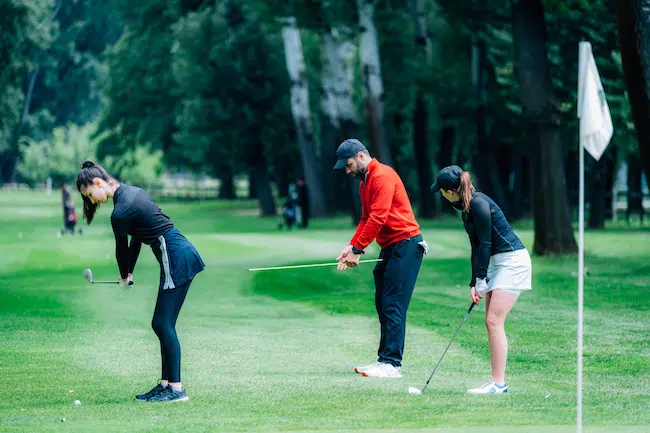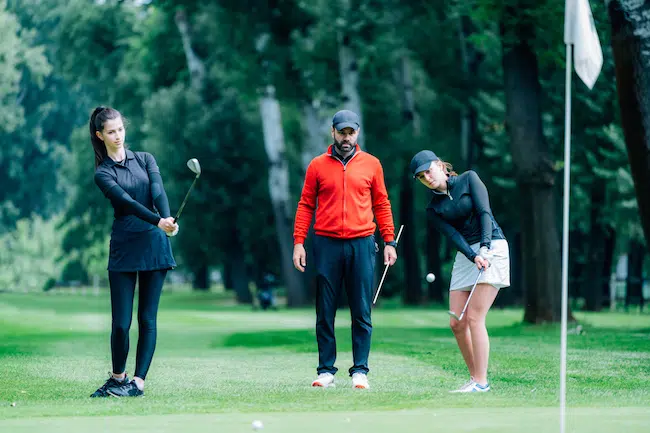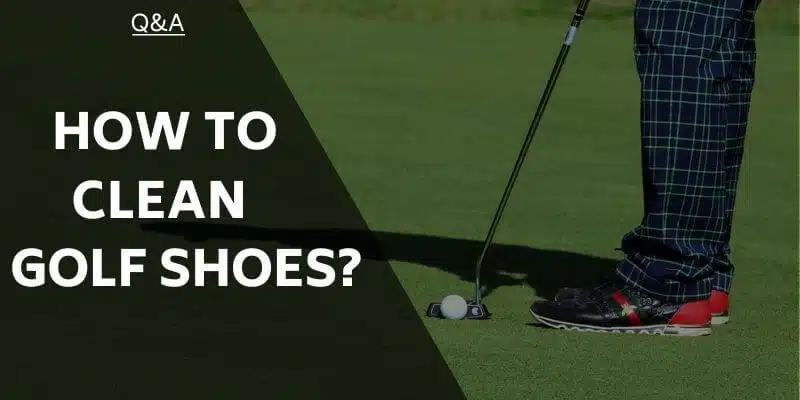An underused shot in golf that has the potential to save you several strokes is the bump and run, also known as the pitch and run golf shot. Or some call it the chip and run. This is a shot similar to a chip but with a one-marked difference. The bump and run is a very useful shot for all golfers.
A bump and run, a type of chip shot, is where the ball gets on the ground quickly and proceeds to the hole like a putt. This type of shot is used with clubs with less loft than wedges, anything from a 9 iron to a hybrid.
The beauty of this shot type is how safe it is to use. Once you have the basics down, it will become a shot that will make you wonder why you have never used it before.
Understanding the Basics of a Bump and Run Shot
The bump and run golf shot is a useful and easy shot to use. When I teach students how to use this type of shot, they are generally taken aback by its ease of use.
Many golfers fall into the trap of using one or two clubs for most of their short-game shots around the green. In many cases, this includes the highest lofted wedge in the bag and perhaps a mid-lofted wedge, such as a 52-degree.
Limiting your short-game arsenal to one or two clubs could cost you strokes.
As its name implies, the basic premise of a bump and run is a shot that puts a very limited amount of air time on the ball. The shot gets on the ground quickly and rolls out like a putt. The shot is typically performed with a less lofted club than you would use for a chip or pitch shot.
Bump and Run vs Chip vs Pitch Shots

The differences between a pitch, chip, and a bump and run is as follows:
- Pitch Shot- A pitch shot is a high-lofted shot. This type of shot carries most of the way to its intended target. A pitch generally imparts much more spin on the ball. Pitch shots are usually used with your wedges (60, 56, and 52-degree wedges, for example).
- Chip Shot- A chip shot is a lower lofted shot than a pitch. However, it is still a shot that imparts some height on the ball. The difference compared to a pitch is that the ball will roll out a little more. A chip generally still uses one of your wedges.
- Bump and Run- A bump and run golf shot has very little air time. The point of this shot is to get the ball on the ground as quickly as possible. There will be a considerable rollout of the ball on a bump and run. A bump and run is usually performed with a 9 iron and higher. You can even perform this shot with a hybrid or 3 wood.
This shot is also referenced occasionally as a bump shot, pitch and run, or chip and run.
The pros on tour, like Rory McIlroy, will often choose to hit this shot with a higher-lofted club. Because they are so talented, they can pull this shot off with a more lofted wedge.
So what is the difference between a bump and run versus a chip shot? The biggest is in the chosen club and the amount of run out you want. A chip shot usually uses a wedge of some kind. A bump and run usually use a 9 iron and up to as much as a 3 wood.
Read Next: How to Break 80 in Golf
When to Use a Bump and Run Shot

Again, the entire purpose of this type of shot is to get the ball on the ground as quickly as possible and let the ball roll out to the hole. This type of shot can be useful in several situations.
- Ball on Fringe with Far Pin- The first spot where it would be advantageous to know how to hit a bump and run is when the ball is on the fringe, but the flag is very far from you. Hitting a pitch shot or even a chip in this situation requires a golfer to have some skill. Especially when under pressure. Once you understand how to execute, a bump and run requires a little less skill to make work.
- Tight Lies- When you have a lie where the ground is very firm, or even one with very tightly mown turf, it is sometimes tough to get a wedge to slide under the ball. This is a perfect scenario for a bump and run shot.
- When you Must Keep it Low- You may have situations around the green when you must keep the ball very low. Perhaps you are under some greenside trees or a bush, and you can not hit the ball higher. On windy days, your ball will not only be affected on fuller shots. Around the green, wind can affect shots too. Getting the ball on the ground quickly is important in these situations.
Advantages of Using a Bump and Run Shot
There are plenty of advantages to using the bump and run shot. Here are a few of those.
- Once Learned, it is a Very Easy Shot- Once you learn how to execute a bump and run shot, you will find it very easy. It’s almost as easy as hitting a put.
- Once Learned, it is a Very Reliable Shot- Once you learn how to hit the bump and run properly, you will find it is extremely reliable. The chances of getting this type of shot close to the hole are usually easier.
- Helpful for Those with the Chip Yips- Some golfers suffer from a phenomenon known as the chip yips. Similar to the putting yips, this is where a golfer has difficulty feeling comfortable over a shot. Because of the discomfort, pulling the trigger and starting the stroke becomes a mental block. The term “chip yips” is a catch-all for those struggling with chipping and pitching.
Many that suffer from this go to using a putter in situations where a chip or chip would be a more appropriate shot choice. Learning a bump and run shot can be a potential solution for those that suffer from chip yips.
You could also use a hybrid for a bump and run if you struggle with chipping.
Disadvantages of Using a Bump and Run Shot
I feel there is only one real disadvantage with the bump and run. However, once you can learn how to hit this shot, this becomes less of an issue.
It Takes Some Time to Learn the Feel- For those not used to hitting the bump and running, it will take some time to gain the right feel. Many golfers will initially find shots going too far. This is common as you learn how to execute the shot. Once you learn the feel, this is a very reliable shot.
It takes practice to gain the confidence to hit the bump and run. Stick with it! If you do, you will be very happy that you did.
How to Execute a Bump and Run Shot

Here is a step-by-step guide on how to bump and run. If you have never tried this shot before, be patient, give it some time and practice, and you will soon see how useful it can be.
Step 1, Evaluation- The first step is to evaluate the shot. You need to basically read the line and break of that shot just as you would with a putt.
Step 2, Find Your Landing Point- Once you have determined how the ball will move, you must decide where your best landing point is once it’s rolling on the green.
Remember, getting the ball on the ground and rolling out as quickly as possible is the point. Your landing point is where the ball will start rolling like a putt. It is important to pick your spot accordingly.
Step 3, Deciding the Correct Club to Use- Once you have decided what your best landing spot is, you will decide which club will suit the situation best. The determining factor on which club would be best for this shot is how far you need the ball to go in the air to hit your landing point.
Step 4, Set Up- A bump and run requires you to set up to the ball in a very similar way as you would with a chip shot.
- Address the ball with your feet very close together
- Stand fairly close to the ball, like you would a putt
- Your ball position will be in the back of your stance
- You will have about 60% of your weight leaning into your lead foot
- Your hands and the shaft will be slightly ahead of the ball
Step 5, The Stroke- As you can gather from how I labeled this step, you are making a stroke rather than a swing. As I mentioned above, in step 4, you will stand very close to the ball as you would with a putt. This will allow you to make a stroke just like you would with a putt.
You will go back and through just as you would in a putting stroke. The loft of your chosen club will get the ball airborne just enough to carry the fringe and hit your landing spot. The ball will then roll out just like a putt.
You must be very still with your body, just as you would with a putting stroke. You will move the arms and club back and through in one piece. There is very little if any body rotation as there would be in a pitch shot.
Remember to stay smooth going back and accelerate through to the finish. The length of your finish will mirror your backstroke length. There is little to no wrist hinge in this type of shot.
Check This Out: What Does Up and Down Mean in Golf?
Common Mistakes to Avoid With the Bump and Run Shot
Some of the common mistakes to avoid with the bump and run include:
- Trying to Do More than Needed- One of the biggest mistakes I see when this shot is attempted is trying to do much more than is necessary. You do not need to use much effort in hitting this shot.
- Using the Wrong Club- The purpose of the club you choose is to get the ball up just enough to hit your landing spot. Once you hit that landing spot, where the ball will start to run like a putt, that is your focus. Don’t use a club that requires you to do more than you need to do to hit your landing spot.
- Indecision as you Hit the Shot- Not having a clear picture of what you want to accomplish before you hit the shot can lead to poor shots. This is true for all golf shots. With the bump and run, indecision can be even more of a problem. As easy as this shot is, once you know how to hit it, you still need to be very decisive in your objective.
Tips for Improving Your Bump and Run Shot
The following are my best tips for getting good at hitting the bump and running.
- Tip #1- The bump and run shot generally requires a very short stroke, likely never going to much higher the hip high to hip high. You don’t need to overdo this shot at all! Especially with a club in your hand with much less loft than a pitch shot.
- Tip #2- To get really good at the bump and run, practice it a lot as you are first learning it. As I mentioned above, most people do too much initially while learning this type of shot. Many are surprised by how little effort is needed to execute this shot properly.
- Tip #3- Making sure you study the green and see how the ball will roll once you hit your landing spot is key. Pick that landing spot carefully, then trust it. Right before you execute the shot, take a few practice strokes to get a feel for what is necessary to hit your spot.
- Tip #4- Be confident! Of course, that is key with anything you do in this game.
2 Drills for Improving Your Bump and Run Shot
There are two drills I like to suggest to students that struggle with the bump and run shot. The first is to help with feel and the second is to help develop good visualization for the shot.
One-Handed Lead Hand Drill: Look Mom, One Hand!
When first introduced to the bump and run, many golfers struggle with getting the feel for the shot. They often feel like they need to do much more than is necessary to get the ball going to the hole.
To help develop a good feel for this shot, I like to have students use their lead hand only in practicing the feel for this type of shot.
By using only your lead hand, you are forced to try and develop good feel and touch to be able to make a good strike at impact. In doing so, most start to understand that the shot does not require too much force to get the ball going enough for the shot.
Penny Landing Spot Chipping Drill: A Penny for Your Thoughts…
The next drill will help you visualize a correct landing spot when hitting the bump and run. This is something that newbies to the bump and run initially struggle with. Often, they will fly the ball too far and watch as it rolls out too far as it zips by the hole.
To do this drill, you will do the following:
- Pick a hole with 40 to 50-foot range from the hole.
- Grab a penny and place the penny on the spot where you feel a good landing point would be for your bump and run.
- Hit three shots; your only focus is hitting that landing spot. Watch how the ball rolls out from your chosen landing spot.
- Analyze your shots: Did it get close to the hole? Did it come up short? Did it roll past too much?
- Adjust the penny as needed and hit about ten more shots. Ask yourself those questions again, and readjust again if necessary.
- Once you find the correct landing spot, place the penny and hit twenty shots.
You can carry over this feel on the course when you need to hit the bump and run. Obviously, you can’t place a penny, but you will now know you must focus on a landing spot.
Read More: Golf Terms Explained – A Complete A to Z of Common Golfing Terms and Sayings
Final Thoughts
One of the most underutilized shots in golf is the bump and run. This is also one of the most useful shots in the game. Learning to hit a bump and run may take a little time to develop, but once you have a feel for it, it will be your new best friend!
FAQ’s
What Club To Use for a Bump and Run?
The best club for bump and run golf shots come down to where you want to land the ball. Study your shot, find your desired landing spot, and then pick your club of choice from there. For example, a bump and run with the flag 80 feet away might require a 4 or 5 iron. A bump and run with the flag 40 feet away might require an 8 or 9 iron.
Do Pros Bump and Run?
Absolutely! In fact, they use this shot much more frequently than you would think. The one thing that the pros do a little more often with the bump and run than most amateurs is use a little more lofted club. The pros are much more skilled and have much better feel and control. So they are able to execute the bump and run with a more lofted club.
One of the greatest shots in golf history was essentially a bump and run. Tiger Woods’ infamous shot on the par three 16th hole in 2005 at the Masters. He could not have picked the landing spot any better. And the ball rolled like a putt right into the cup!
How Far Can You Hit a Bump and Run?
You could conceivably use this shot from as far out as 75 to 100 yards. Think of links courses and the Open Championship. In these situations, because of the design and terrain of the course and often windy conditions, a bump, and run is ideal.
Using a less lofted club than you normally would from as much as 100 yards and hitting a bump-and-run shot can be very useful in these situations.
Brendon is Class A PGA Professional and founded Little Linksters, LLC, and its nonprofit arm, the Little Linksters Association for Junior Golf Development. He won 25+ prestigious industry honors, including the 2017 PGA National Youth Player Development Award. He graduated from the PGA of America Management Program and has a handicap index of 7.8.
He has played golf for over 40 years and currently plays twice a month at the Eagle Dunes Golf Club near Sorrento, Florida. He loves Srixon clubs and plays a ZX5 driver with Z 585 irons. He's written over 60 articles on GolfSpan and specializes in sharing tips to improve your golf game. You can connect with Brendon at LinkedIn, X, IG, FB, his website, or BrendonElliott@pga.com.
- Best score: 69
- Favorite driver: Srixon ZX5
- Favorite ball: Srixon Z Star
- Favorite food at the turn: Turkey and cheese on white







